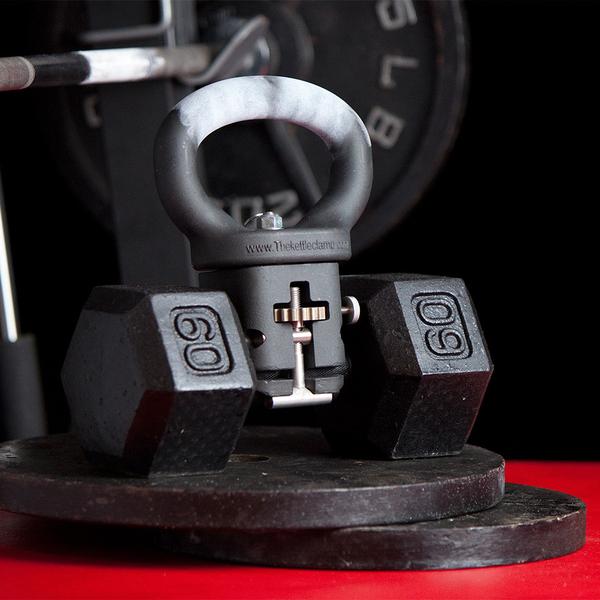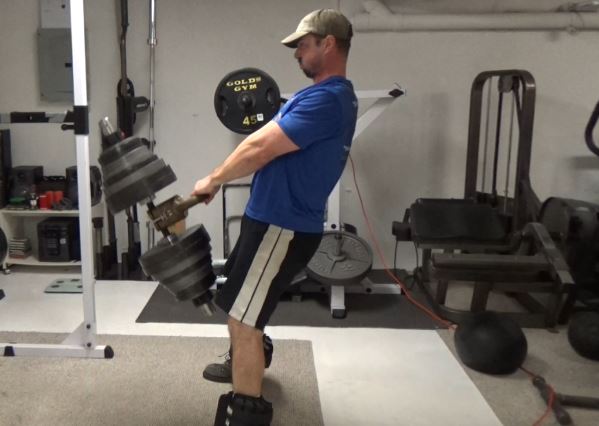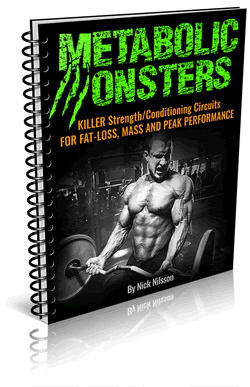Kettlebell training is excellent...I'll tell you that right now.
And if you've never tried kettlebell training because you didn't have access to kettlebells, I've got a review of a piece of equipment that can help. It's called the KettleClamp.
What is the KettleClamp?
The goal of the KettleClamp is very simple...turn your dumbbell into a kettlebell by clamping a kettlebell-like handle onto it.
This allows you to do a variety of kettlebell exercises when you only have access to dumbbells.
It attaches to your dumbbell with a unique mechanism that, once you get the hang of it, takes only seconds to put on and take off your dumbbells.

The KettleClamp handle itself is built VERY solid...it has a nice, thick handle with a comfortable grip and the current version even has rubberized cushioning on the inside of the clamp to better grip the dumbbell and prevent any possible scratching of the handle.
|
Step 1 - Attaching the KettleClamp
The design of the KettleClamp is really clever. It has a "mouth" at the bottom that opens up and goes around the dumbbell handle.

It has a T shaped locking mechanism that fixes the "mouth" in place. Then you just spin the rotary lock-down piece to lock the whole thing in place. There is also a small screw you can tighten up to lock that rotary piece in place for total security.
Once on, the KettleClamp is absolutely SOLID on the handle.

It may sound complicated but once you've done it a few times, it's VERY easy...I didn't even have to read instructions to figure it out the first time I used it.
Step 2 - How and Why to Rotate the KettleClamp Handle
One thing I found extremely useful about the Kettleclamp (KC) is the ability to rotate the handle 90 degree and lock it into place.
To accomplish this, first get the KC locked on to your dumbbell...it'll give you better leverage to turn the handle. Then pull the pin on the top of the KC to unlock it.

Then all you have to do is rotate the handle until the pin pops back down into the locking position again.
So why would you want to rotate the handle?
You want to to do this because the handle functions better for different exercises in different positions.
For example, when doing a Kettlebell Swing exercise, you want the KC handle to be perpendicular to the dumbbell handle. If it's parallel to the dumbbell handle and you're using a larger dumbbell, you'll have to stand with your legs WAY too far apart to perform the movement properly.
Conversely, when doing an exercise like Farmers Walks, you DO want the KC handle to be parallel to the dumbbell handle so the dumbbell hangs at your side. And these handles are MUCH better for Farmers Walks than dumbbells, because they allow the weight to carry lower than dumbbells allow you to (they hit the hips constantly).
How to do Kettlebell Swings With the KettleClamp
In talking with the inventor of the KettleClamp, he let me know that he originally created this to be used with kettlebell swings...and if you've used kettlebell swings before, you know what a phenomenal exercise this is for not only your posterior chain (the muscles that run down the back of your body) but pretty much the ENTIRE body as well.
So in testing the KettleClamp, the swing was the first exercise I tried.
And I do have to say, the ability to load the kettlebell swing with the amount of weight that I have available to me in my dumbbells is an eye-opener!
The heaviest I've done kettlebell swings before was with a 50 lb kettlebell...it's all I had access to. And at 50 lbs, I could tell it was an excellent exercise.
Now that I've had the ability to REALLY load the exercise, my opinion of the exercise has gone WAY up. It's an incredibly effective movement to start with and loading it heavy (while keeping proper form, of course) makes it even better.
Here's what it looks like with the KettleClamp setup...
When using heavier weight, the first swing starts with a small backswing then a half swing up, to get some momentum built up.



On the backswing, you're going to let the weight swing back and between your legs. Make VERY sure you keep an arch in your lower back, core tight and knees slightly bent.
The MOST important key to remember with the Swing exercise is that it's a HIP exercise, not an arm or shoulder exercise. The power comes in snapping your hips forward...almost like you're trying to ring a doorbell with your hip bones.


I find the kettlebell swing done with the KettleClamp to be extremely effective...it's exactly the same as a kettlebell swing in terms of form and the ability to load the exercise with the heavier weight generally available with dumbbells is HUGE positive.
I've gone as high as 285 lbs on a home-made dumbbell and the KettleClamp worked like a charm. Here's what that looked like.

Something like this is absolutely NOT possible with a standard kettlebell (I don't think they even make them that heavy!).
Other Exercises You Can Do With the KettleClamp
Now, if you know me, you know I can't resist taking a piece of equipment and seeing what else I can do with it, other than the use for which it's intended.
And I find that's where the KettleClamp really shines. As a piece of training equipment, it really opens up a lot of possibilities beyond just kettlebell swings.
One caveat, however, is this...to really make full use of the KettleClamp in other exercises, it's better to have two of them. You'll see what I mean when I show you some of the exercises.
Farmers Walks With the KettleClamp
This is an easy one...just pick up the KettleClamp(s) and dumbbells and do a Farmers Walk.
If you're not familiar with the exercise, it's simple. You just hold weight at your sides with arms straight and you walk. This works your legs, core, grip, traps, upper back...the works. It's a GREAT exercise.
I find doing the Farmers Walk with the KettleClamp handles to be much better than straight-up dumbbell Farmers Walks. With dumbbells, you have the weight plates forward and back with your hand as the balance point in the middle. As you're walking with heavy dumbbells, the pinky sides of grip will fail first and the dumbbells will start to tilt and contact your forearms.
With the KettleClamp, this is not an issue. The hand is still the balance point but since the dumbbells are now hanging down below, there's no tilting. You can walk until your grip peels right off the handles and the dumbbells won't get in the way.



The other thing I like about the KC Farmers Walk is that the KC handles are thicker than the standard dumbbell handle, working your grip even harder.
Lockout Trap Bar Deadlifts With the KettleClamp
In the demo video above, I've also included an exercise that I've trying for YEARS to find a good way to do lockouts with...and that's the Trap Bar Deadlift.
The KettleClamps lock right onto the handles of the Trap Bar, essentially extending the grip upwards, shortening the range of motion that you actually have to lift the barbell off the ground.


This shortened range of motion means you can lift more weight. I'm using 6 plates on the bar in the demo, which is 585 lbs.
The Trap Bar Deadlift is already one of my favorite exercises...this allows you to REALLY overload the exercise even more.
Rowing With the KettleClamp
The KettleClamp can be use for a variety of very effective rowing movements. Watch the video below to see a few of these variations.
The first exercise is the Incline Bench Chest-Supported Barbell Row (neutral grip). I've got two KettleClamps attached to an Olympic barbell and I'm laying chest-down on the incline bench.

The benefit of this variation comes at the top of the row. When you're using a regular barbell, the bar will hit the bench before you get the complete contraction in your back.
With the KC's extending your grip down, the bench no longer gets in the way and you can row until you hit maximum contraction in the back.

I've also found that gripping on the KC's really forces me to activate the rhomboids and middle traps to draw the shoulder blades in towards the spine first, before the rowing movement starts.
This is much harder to do with the straight barbell...with the KC's, it's pretty much automatic. This benefit makes this rowing version excellent for back development.
The same thing applies to a standard bent-over barbell row. It allows you to pull without the bar hitting your abdomen and forces the rhomboids and middle traps to activate first, keeping your form tight.


The key thing to note here is that you should use a fairly light weight when doing these so that you do keep your form strict. If you go too heavy, you could lose that major benefit.
Here's the Incline Bench Chest-Supported Row done with a pronated grip to target the upper back more (the neutral grip brings the lats into play more than this version).

Finally, I've got the Seated Cable Row exercise done with KC's attached to the handle.
This pic shows the setup...the handles are set in the neutral-grip position, clamped onto a straight bar attachment.

The rowing movement is the same.


Having the KettleClamps on the handle allows for greater range of motion than you'd be able to hit with the straight bar or parallel handle attachments.
Chin-Ups and Pull-Ups With the KettleClamp
So in addition to the rowing exercises you can do with the KettleClamp, you can also take the next logical step and attach the KC's onto a chin-up bar to do chins and pull-ups.
The exercises are performed pretty much exactly the same...no surprises here. However, there are actually THREE major benefits of using the KC's in this fashion.
First, you take the bar out of the way. You can pull your body up in between the handles both in chin-ups and pull-ups.
Second, the handles can spin/move somewhat freely on the bar. This means your hands aren't locked in on the bar as much, which can spare you shoulder pain while still keeping some degree of stability in the movement.
Third, you can rotate the KC handles, allowing you to do neutral grip chin-ups. If all you have is a straight bar, this opens up another exercise variation for you on the chins.
The first exercise is the pull-up. Set the the KC's on the bar with handles parallel to the bar.


You'll notice that I'm able to bring my head directly up in between the two handles. This actually gives you some of the benefits of the Behind-The-Neck Pull-Up without the shoulder stress involved in that position. The handles swing freely on the bar and you don't have to force your head in front of the bar.
My shoulders aren't great and I can do this one with no pain at all.
Here's the neutral-grip chin-up.


And now the neutral wide-grip pull-up. I find this really targets the lower lats strongly.
I prefer to perform this one in the middle part of the range of motion, not coming all the way down (which could overstretch the shoulders) and not coming all the way up to the top (which uses a lot of bicep action).


The final version of the pull-up is the Upside Down Pull-Up Row.
Set the handles to the neutral position, a little wider than you had them for the chin-ups. Next, you're going to kick yourself up and around until you're upside down.
Then you're going to do a rowing movement with your bodyweight.



This exercise really stretches out the muscles of the mid-back effectively. At the bottom, your arms are straight and your bodyweight is bearing down, forcing that stretch.
When doing this one on a straight bar, you don't get full range of motion...the back of your legs hits the bar. When you extend your grip with the KettleClamps, you can pull up until full contraction.
The Downsides of the KettleClamps...
Now, as much I as love this piece of equipment (and I do...I think it's awesome, especially when used as a pair), it has two downsides that you need to know about up front.
1. Cost
If you're on a limited budget, at $159 the KettleClamp might be beyond what you can afford...and just to clarify, that's for ONE KettleClamp, not for a pair.
That being said, the extremely high quality of the equipment means that you'll never have to buy another one again (unless you want to get two, which if you can afford it, I HIGHLY recommend). This thing can take a serious beating and is rated to 1000+ lbs. It has very few moving parts and is very unlikely to break.
This is a great piece of equipment for gyms, athletic training facilities, home gyms and serious users. It's not something the casual user may want to spend the money on.
2. Not all Kettlebell exercises are doable with the Kettleclamp
As I mentioned at the start, the KettleClamp was originally designed to do kettlebell swings with. For example, I wouldn't recommend doing kettlebell snatches with it...I've tried. And while it is doable with lighter weights, as you get into heavier weights, it can get awkward.
Conclusion:
Overall, I'm a BIG fan of the KettleClamp. Obviously, cost is going to be an issue but the exercises you can perform with the KettleClamp absolutely make this a worthwhile investment for the right person (gym owner, home gym owner, strength coach, boot camp trainer and serious gym-goer).
In addition to the purpose for which it was designed (swings), the KettleClamp can be used for a tremendous variety of exercises, most specifically back training.
Bottom line, this is a piece of equipment that gets my HIGHEST marks and recommendation.
Unforutunately the KettleClamp is no longer in production

![]()
More From Fitstep.com
Share This Page...
---
Home -> Muscle and Strength -> Training Equipment Reviews -> KettleClamp

